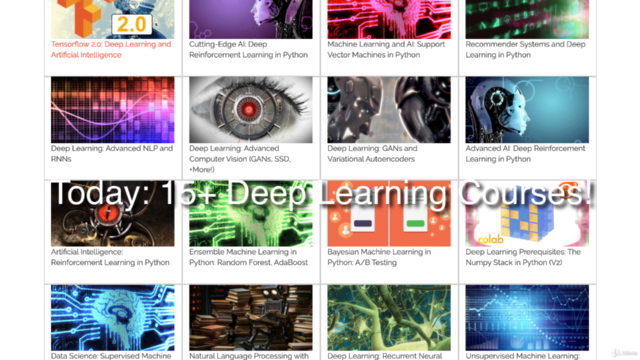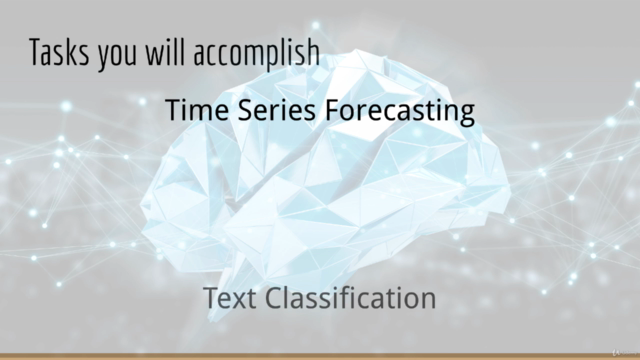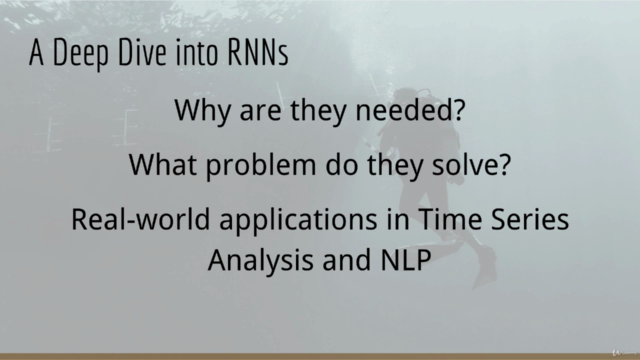Deep Learning: Recurrent Neural Networks in Python

Why take this course?
🌟 Deep Learning: Recurrent Neural Networks in Python 🌟
NOW IN TENSORFLOW 2 and PYTHAN 3!
🚀 Course Description:
Have you ever been fascinated by the cutting-edge artificial intelligence technologies like OpenAI's ChatGPT, GPT-4, DALL-E, Midjourney, and Stable Diffusion? In this comprehensive course, we'll dive deep into the inner workings of these remarkable AI applications through the lens of Recurrent Neural Networks (RNNs).
🤖 What You'll Learn:
- The fundamental concepts of Machine Learning and the role of neurons.
- Advanced neural networks for classification, regression, and more, as a refresher to set the stage for new learnings.
- Mastering sequence data modeling and its applications in various fields.
- The art of predicting time series data with RNNs, and how to forecast future trends and stock market movements.
- Techniques for text preprocessing and understanding the power of Embeddings in NLP.
- Crafting your own Recurrent Neural Network models using Tensorflow 2 to solve real-world problems like spam detection, sentiment analysis, and named entity recognition.
👩🏫 Course Highlights:
- All materials are accessible for FREE, designed to work with Numpy, Matplotlib, and Tensorflow.
- A hands-on approach: building models from the ground up rather than just using APIs.
- Emphasis on understanding through experimentation, not mere memorization.
- Visualize what's happening internally in your RNN models.
- Learn to implement machine learning algorithms from scratch—the only way to truly understand them.
- Go beyond the basics with a focus on implementation and deeper understanding.
📚 Prerequisites:
Before jumping into this course, make sure you have a grasp on:
- Basic matrix operations (addition, multiplication).
- Core concepts of probability, including conditional and joint distributions.
- Proficiency in Python coding with if/else statements, loops, lists, dictionaries, sets, and Numpy functions for matrix and vector operations as well as CSV file handling.
📖 Order of Learning:
- For an optimal learning path, refer to the "Machine Learning and AI Prerequisite Roadmap" lecture available in any of our courses, including the free Numpy course.
✨ Unique Features:
- Every line of code is meticulously explained—if you ever find anything unclear or missing, reach out, and I'll address it!
- No time wasted on needless coding exercises that don't contribute to your understanding.
- Delve into university-level math for a more comprehensive understanding of algorithms typically glossed over by other courses.
Join me on this journey to unravel the mysteries of Recurrent Neural Networks and harness their power to solve complex problems using Python and Tensorflow 2. Let's turn your curiosity into competence! 🚀💫
Course Gallery




Loading charts...
Comidoc Review
Our Verdict
Deep Learning: Recurrent Neural Networks in Python offers an extensive exploration into GRU, LSTM, time series forecasting, natural language processing, and image classification. With clear theoretical explanations and hands-on experience in Tensorflow 2, this course is particularly valuable for those looking to grasp the intricacies of various RNN variants. However, be prepared for an independent learning approach due to limited exercises, occasional disorganization in structure, and varying teaching intensity throughout.
What We Liked
- Covers a wide range of deep learning topics including time series forecasting, natural language processing, and image classification using recurrent neural networks (RNNs)
- In-depth explanations of theoretical foundations and practical applications of GRU, LSTM, and other RNN variants
- High-quality code demonstrations in Tensorflow 2 with clear instruction on how to mitigate the vanishing gradient problem
- Engaging teaching style with a good sense of humor, making the learning process enjoyable and effective
Potential Drawbacks
- Some students may find the pace slow and lacking specific exercises or capstone projects, requiring independent initiative to reinforce understanding
- Occasional disorganization in course structure, potentially causing confusion for beginners
- Lack of access to promised code notebooks for certain students, impacting the learning experience negatively
- Overemphasis on theory and repetition in some parts of the course may deter some learners seeking a more concise approach